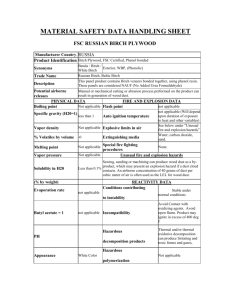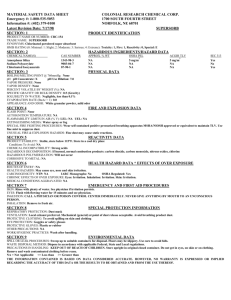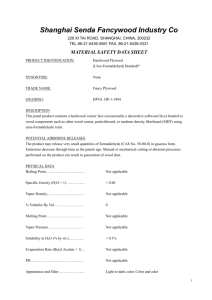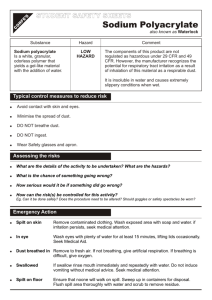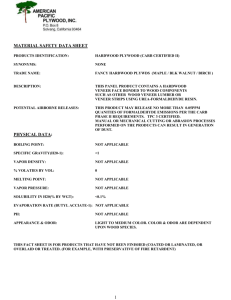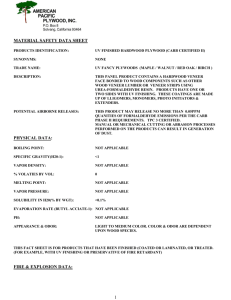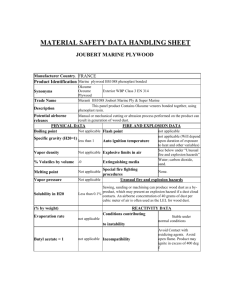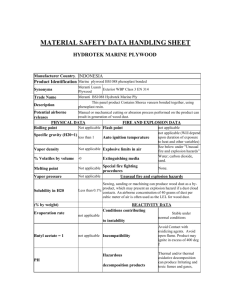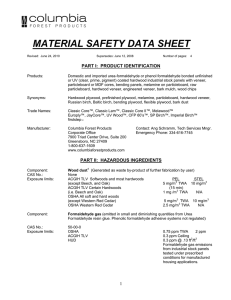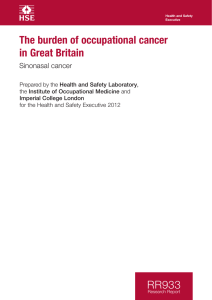Material Safety Data Sheet - TimberCreek Hardwood Flooring
advertisement
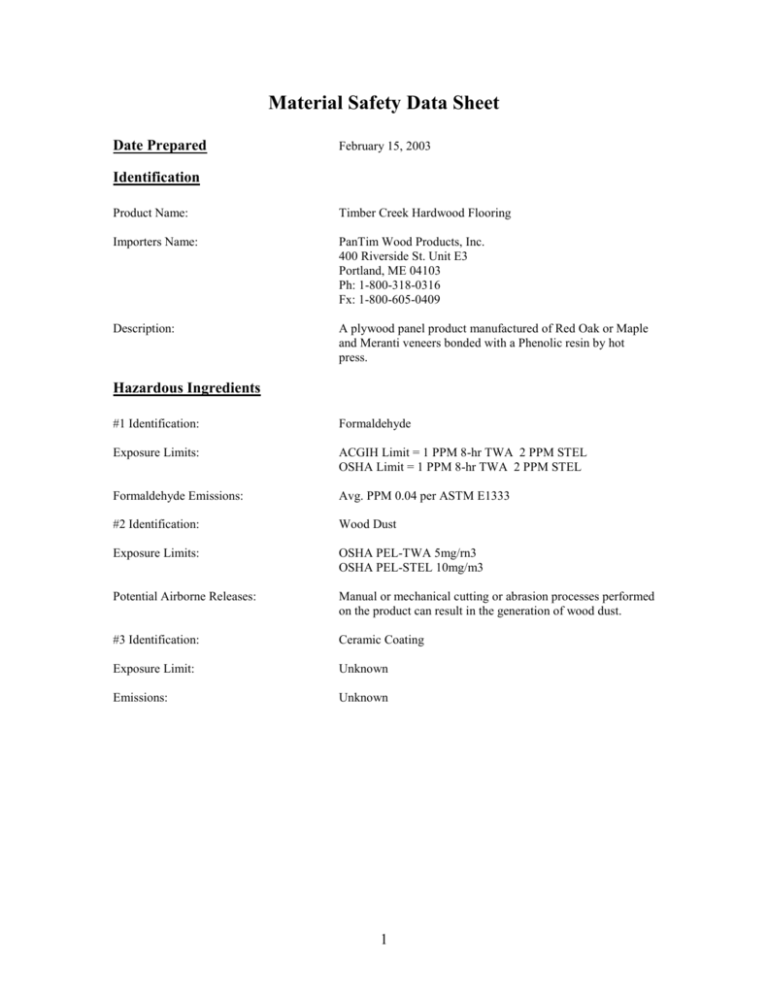
Material Safety Data Sheet Date Prepared February 15, 2003 Identification Product Name: Timber Creek Hardwood Flooring Importers Name: PanTim Wood Products, Inc. 400 Riverside St. Unit E3 Portland, ME 04103 Ph: 1-800-318-0316 Fx: 1-800-605-0409 Description: A plywood panel product manufactured of Red Oak or Maple and Meranti veneers bonded with a Phenolic resin by hot press. Hazardous Ingredients #1 Identification: Formaldehyde Exposure Limits: ACGIH Limit = 1 PPM 8-hr TWA 2 PPM STEL OSHA Limit = 1 PPM 8-hr TWA 2 PPM STEL Formaldehyde Emissions: Avg. PPM 0.04 per ASTM E1333 #2 Identification: Wood Dust Exposure Limits: OSHA PEL-TWA 5mg/rn3 OSHA PEL-STEL 10mg/m3 Potential Airborne Releases: Manual or mechanical cutting or abrasion processes performed on the product can result in the generation of wood dust. #3 Identification: Ceramic Coating Exposure Limit: Unknown Emissions: Unknown 1 Physical Characteristics Boiling Point: N/A Specific Gravity (H20=1): Less than 1 Vapor Pressure: N/A Melting Point: N/A Vapor Density: N/A Reactivity in Water: N/A Evaporation Rate: N/A Appearance: Varies by Species and Stain Color Fire and Explosion Data Flash Point: N/A Auto Ignition Temperature: 425 Degrees to 475 Degrees Explosive Limits in Air: The product listed in this MSDS is not an explosion hazard. Sawing, Sanding, or Machining could result in the by-product wood dust. Wood dust may present a strong to severe explosion hazard if a dust cloud contacts an ignition source. Fire Extinguishing Media: Water, Carbon Dioxide, Sand Special Fire Fighting Procedures: Fire fighting procedures for wood are well known 2 Health Hazard Data 1.1 Formaldehyde Vapor/ Signs and Symptoms of Exposure: Acute=may cause temporary irritation of skin, eyes, or respiratory systems. May cause Sensitization in susceptible individuals. Chronic=Numerous epidemiological studies have failed to demonstrate a relationship between Formaldehyde exposure and nasal cancer or pulmonary diseases such as emphysema or lung Cancer. UAREP concluded that there was no “Convincing Evidence” that formaldehyde exposure causes cancer in humans. Rats exposed to 14PPM of formaldehyde for 24 month in a laboratory developed nasal cancer. Exposure of 6PPM did not result in statistically significant levels. The NCI epidemiological study of 26,000 workers found little evidence linking formaldehyde exposure to cancer. Formaldehyde is classified by OSHA, NTP and IARC as a probable or potential Carcinogen 1.2 Medical conditions Aggravated by Formaldehyde exposure: 1.3 Emergency First Aid Procedures: 2.1 Wood Dust Respiratory conditions or allergies Inhalation: Remove to fresh air Eyes: Remove to fresh air Skin: Remove to fresh air Ingestion: N/A If irritation or other symptoms persist, consult a physician Eye Contact: Wood dust can cause mechanical irritation. Skin Contact: Various species of wood dust may evoke allergy in sensitive individuals Ingestion: Not likely to occur Burning: According to ISO/DIS 5660 tests, the toxicity index of fire effluents was small, but there are many compounds in smoke oases which can cause irritation to eyes, nose & throat Inhalation: Wood dust may cause nasal dryness, irritation and obstruction. Coughing, wheezing and sneezing: sinusitis and prolonged colds have also been reported. Depending on species, wood dust may cause dermatitis on prolonged, repetitive contact; may cause respiratory sensitization and/or irritation. IARC classifies wood dust as a carcinogen to human (Group 1). This classification is based primarily on IARC’s evaluation of increased risk in the occurrence of aden carcinomas of the nasal cavities and para nasal sinuses associated with the exposure to wood dust. IARC did not find sufficient evidence to associate cancer of the oropharynx, hypo pharynx, lung, lymphatic and hematopoletic systems, stomach, colon or rectum with exposure to wood dust. Wood Dust classification from ACGIH: Hard Woods and Softwoods (non-allergenic); “A4 irritation, mucastasis” except Birch and Oak 3 2.2 Emergency and First aid Procedures: Eye contact: Flush eyes with large amounts of water. Enable fresh air environment. If irritation persists, get medical attention. Skin contact: Wash affected areas with soap and water. Get medical advice if rash or persistent irritation or dermatitis occurs. Inhalation: remove to fresh air. Get medical advice if persistent irritation, severe coughing or breathing difficulty occurs. Ingestion: Not applicable Reactivity Data Conditions contributing To Instability: Incompatibility: Hazardous decomposition Products: Hazardous polymerization: Stable under normal conditions Avoid contact with oxidizing agents & strong acids. Avoid open flame. Product may ignite in excess of 425 degrees. Thermal and/or thermal-oxidative decomposition can produce irritating and toxic fumes and gasses, including carbon monoxide, aldehydes and organic acids. N/A Precautions, Safe Handling Handling and Storage: Personal Protective Equipment: There may be a buildup of noxious gases in temperatures higher than 212 degrees. Provide adequate ventilation to reduce the possible buildup of formaldehyde vapors above OSHA PEL’s. Wear goggles or safety glasses when manufacturing or machining the product. Wear NIOSH/MSHA approved respirator when allowable exposure limits may be exceeded. Other protective equipment such as gloves and outer garments may be needed depending on dust conditions. 4

